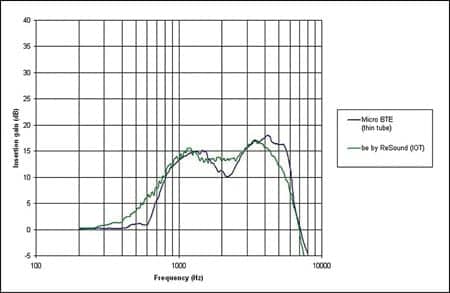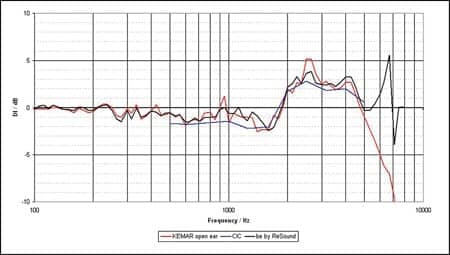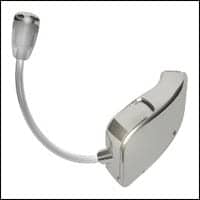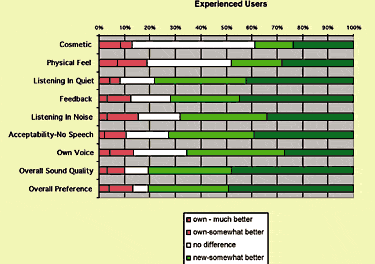Small, behind-the-ear (micro-BTE) hearing instruments that connect to the ear canal via a thin tube and silicone dome changed the hearing aid industry. Because they do not occlude the ear canal and are comfortable to wear, such open-fit micro-BTEs have become the solution of choice for hard-to-fit individuals with normal or near-normal low frequency hearing and sloping high frequency hearing losses. As evidence of this, practitioners reported that, on average, 41.6% of the hearing instruments they dispensed in 2007 were open-fit micro-BTE.1
| This article was submitted to HR by Charlotte T. Jespersen, MA, manager of research audiology at GN ReSound AS in Ballerup, Denmark, and Jennifer Groth, MA, director of clinical audiology at GN ReSound research and development, Glenview, Ill. Correspondence can be addressed to [email protected] or Charlotte Jespersen, GN ReSound AS, Lautrupbjerg 9, Postbox 130, DK-2750 Ballerup, Denmark; e-mail: . |
A high degree of user satisfaction with this style of hearing aid is likely the major driver behind the trend. Christensen and Matsui surveyed 136 open micro-BTE wearers, and showed them to be more satisfied with their instruments than other hearing instrument users on various product dimensions, including comfort, visibility, appearance, and sound quality, as well as in many listening environments (unpublished data; Hearing Aid Satisfaction with ReSoundAIR, GN ReSound white paper, 2004).
While the primary advantage of open-fit micro-BTEs is elimination of the occlusion effect, the typical small size of the device and the inconspicuous thin tube also provide benefits in terms of cosmetic appeal. Open-fit micro-BTEs have thus supplied the hearing care professional with an important tool to chip away at one of the most insidious barriers to hearing instrument use: stigma.
Since one aspect of hearing aid stigma is being associated with aging and infirmity, devices that are discreet or resemble other communication devices can help in attracting new users and making them feel more confident in their choice to use amplification. Kochkin2 estimated that half of people with significant hearing loss do not try hearing aids due to stigma. His results further suggested that stigma is age related. When hearing loss was controlled for, individuals under 65 years were found to be three to four times less likely to acquire hearing aids than those older than 65. This is especially sobering considering that 65% of the more than 31 million people in the United States with hearing losses are younger than 65.3
Hearing-impaired individuals with normal or near-normal low frequency hearing and sloping high frequency hearing losses can be provided with comfortable, occlusion-free, cosmetically appealing instant fittings by fitting them with open micro-BTE instruments. However, the picture is not completely rosy. Some individuals simply do not want a hearing aid that is placed behind the ear no matter what benefits it provides. Moreover, users of open micro-BTEs do report negative side effects experienced with this style.

|

|
| FIGURE 1. The be by ReSound is a invisible open technology (IOD) device. Using a counterintuitive design, the microphone is located outside the housing unit and is worn in the concha cymba. The housing/receiver unit is inserted into the ear canal. | |
For one thing, the behind-the-ear device placement may interfere with glasses. Because the devices are so lightweight and are not tightly seated in the concha, it is a common occurrence that they come off when glasses, a hat, or a sweater are removed. Wearers with dynamic ear canals may periodically need to reseat the tubes in their ear canals, as jaw movements can gradually push the tubes out of the ears.
In addition to these inconveniences, acoustic disadvantages related to the device location behind the ear exist. One of these is that individuals with longer hair may be annoyed by the amplification of noise from hair brushing against the device casing. Second, the microphone location outside of the pinna disturbs acoustic cues important for localization. Finally, BTEs are particularly susceptible to wind noise.
A New Hearing Instrument Style

|

|
| FIGURE 2. Cross-sectional Illustration of slit leakage venting with be (left) compared to conventional custom device venting in the ear canal (right). The white represents the device, and the blue shows the venting or slit leakage. The new IOT strategy results in a very large vent area around the device. Demonstration of this principle is available at www.bebyresound.com. | |
As the creator of the recent open-fit product category, ReSound set itself the goal to offer hearing aid users an alternative to open micro-BTEs that would preserve the aforementioned benefits and instant-fit convenience while minimizing the negative side effects. Like the open-fit micro-BTE, such a device would still leave the ear canal unoccluded, provide adequate feedback-free gain for high frequency hearing losses, fit comfortably in most ears, and not call attention to itself when worn. The successful design would also conjure an appealing high-tech and modern image, as well as solve the acoustic challenges associated with the BTE style.
These requirements implied an in-the-ear style device. By merging the concept of the barely visible CIC hearing instrument with the space-saving concept of separating components—as utilized in receiver-in-the-ear BTE instruments—a new style of device was conceived.
The new device, called be by ReSound, is the first example of a invisible open technology (IOP) hearing instrument (Figure 1). It consists of a miniature modular ear canal unit including the digital electronics, battery compartment, receiver, and wax filter. Flexible, transparent tubing that ends in an encapsulated microphone extends from the ear canal unit’s battery compartment. The entire ear canal unit inserts into the ear canal such that it is flush with the ear canal entrance. The tubing lines the perimeter of the concha bowl and the microphone capsule tucks into the concha cymba.
Conventional wisdom has dictated that to ensure wearing comfort, the part of a hearing aid to be worn in the ear canal should be formed to the shape of the ear canal either by being custom-made from an impression or by using a pliable material. The fitting traditionally is made open by ventilation holes through this earpiece. Through a deliberately counterintuitive design, be achieves openness by making minimal contact with the wearer’s ear canal.
Figure 2 is a concept drawing contrasting a cross-sectional representation of this device in the ear canal with a custom-made in-the-ear device. The boxy shape of be, when placed in the oval-shaped ear canal, creates large slit leaks around the entire perimeter of the modular ear canal unit as shown in Figure 2. Because the microphone is located outside the device, the ear canal unit could be made small enough to fit in this way in the majority of ear canals.
This article will present evidence supporting that this new device concept provides benefits comparable to open-fit micro-BTEs in terms of occlusion reduction and wearing comfort, as well as natural-sounding amplification for individuals with mild-to-moderate high frequency hearing losses.
Freedom from Occlusion
Hearing instruments that block the ear canal cause a buildup of primarily low frequency sound pressure in the ear canal for body-conducted sounds, such as the wearer’s own voice. If low frequency thresholds are relatively good, the wearer is likely to experience the occlusion effect: sounds are perceived as excessively loud, boomy, and unpleasant. An open fitting is one in which the ear canal is not occluded, thereby allowing self-generated sounds to escape from the ear canal. A non-occluding fitting is evidenced by objective measures of occlusion effect, as well as subjective judgments relative to occlusion.
Currently, occlusion effect is objectively measured via probe microphone measures in one of two ways. One of these is to compare the level of the wearer’s own voice at the reference microphone to the level in the ear canal. This test method is utilized in the Audioscan Verifit, as well as the Etymotic Research ER-33 occlusion meter. Alternatively, the level of the wearer’s own voice or a bone-conducted stimulus measured in the ear canal can be compared in the occluded and unoccluded conditions. This test method is implemented as a special test in the GN Otometrics VSM, but can also be done with any probe microphone equipment. Both of these test methods were used in laboratory investigations and field trials of the be, and objective occlusion was found to be less than 5 dB in 241 of 263 (92%) adult ears tested regardless of how it was measured. The mean objective occlusion effect was 1 dB (SD 1 dB), which is comparable to the objectively determined occlusion of 0 dB for the type of open dome used for many micro-BTE fittings.4
In testing this product, it was anticipated that objectively measured occlusion would generally be greater for female ears than for male ears. This was based on findings that ear canals in females have smaller dimensions and smaller volumes than male ears.5,6 It follows that the device would occupy proportionally more space in female ears, and it was thus expected that they would experience greater occlusion.
The device was placed in 263 adult ears to determine the fit in the ear. Contrary to expectations, no significant gender differences in objective occlusion were revealed between the 136 adult male ears and 127 adult female ears tested. The reason for this is most likely that candidates who might have been more occluded were not included in the trials because the device did not fit in their ear canals, and that most of those were female.
Based on the total number of ears in which the device was attempted to be fit, it is estimated that be will fit in 80% of adult female ears and 90% of adult male ears if slight protrusion from the canal is cosmetically accepted. If the device physically fits in the ear, the occlusion will probably be less than a few decibels.
Regardless of what objective occlusion is determined to be, the perception of body-conducted sound when wearing the device is the ultimate measure of whether the fitting is occlusion-free. Kiessling et al4 found that individuals with good low frequency hearing rated their own voices as natural sounding as long as objectively measured occlusion was below 15 dB. It was therefore expected that be would rate favorably in terms of perceived occlusion. This indeed was the case. The perceived occlusion with the new device was evaluated by asking 148 trial participants (70 female, 78 male) to rate the naturalness of their own voice while reading a text sample aloud on a 10-point scale with the device in both ears and turned off (“0” indicated very natural sound of own voice; “9” indicated very unnatural sound of own voice). The mean perceived occlusion rating was “2” with a standard deviation of 2. Nearly 90% of the individual ratings were below “5,” suggesting that the vast majority of wearers did not perceive the be devices to be occluding.

|
| FIGURE 3. Wearing comfort ratings with the new IOT device. |
Comfortable to Wear?
be is an instant-fit hearing instrument with the ear canal unit being somewhat rectangular in shape. While this unusual hearing aid shape ensures the slit-leakage venting, making the device non-occluding, on first impression concerns might arise regarding physical comfort for an extended period. Wearing comfort was thus another focus area during the development process. Initially, normal-hearing ReSound employees wore dummies of the device during daily activities to evaluate comfort and retention in the ear.
Encouraged by the positive remarks from these viability studies, a series of three field trials with a total of 75 participants wearing working devices was carried out. Participants wore the devices for periods ranging from 4 to 8 weeks, and datalogging indicated average wear times ranging from a few hours per day to more than 15 hours per day. The participants in these trials were either inexperienced with amplification, wearers of CIC instruments, or wearers of open micro-BTE instruments. All were asked to rate wearing comfort on a rating scale from 1 to 10, with 1 being “uncomfortable” and 10 being “very comfortable.” As shown in Figure 3, be rated highly in terms of comfort by all three groups of participants. Wearers of open-fit micro-BTE instruments rated comfort as equivalent to that of their own hearing aids, while CIC wearers rated the comfort of the device as significantly better than their own (P<0.05). The participants with no hearing aid experience rated comfort similarly to the other two groups.
An interesting observation was that the CIC wearers rated the comfort with the IOT devices significantly better than the micro-BTE wearers did (P<.05). Since there was no difference in how either group rated the comfort of their own hearing instruments, this suggests that the wearing comfort benefits of the new device may be particularly appreciated by those with CIC experience.

|
| FIGURE 4. Real ear insertion gain for the be compared to an open-fit micro-BTE with thin tube. The new IOT device provides a smoother frequency response since the sound is not affected by tube resonances. |
Acoustic Advantages
The new device provides the same sound quality advantage of any open fitting, such as a natural sounding own voice and unobstructed access to low frequency and high input level sounds for which open-fit candidates do not require amplification. In addition, it provides a relatively broad, flat insertion gain response by virtue of the receiver placement in the ear canal.
The green curve in Figure 4 shows the mean insertion gain (n = 121) for the be. The devices were programmed to provide 15 dB insertion gain from 1000 Hz to 6000 Hz in order to verify the real ear frequency response as well as to check that the fitting software view accurately represents the real ear gain. The blue curve shows results for a micro-BTE fit with a thin tube. By comparison, the results for the new device do not show the dips and peaks that are typical for BTE hearing instruments that deliver sound to the ear canal through a tube. A smooth frequency response is often thought of as the “holy grail” for hearing instrument designers, as a peaky response makes it more difficult for the clinician to make all sounds audible without some being too loud—with possible detrimental effects on both sound quality and speech understanding. For this reason, it is often speculated that open-fit micro-BTE devices with the receiver-in-the-ear offer better sound quality than those with the receiver-in-the-aid. Although this specific assertion remains unproven, a smooth response—such as that of the IOT device—represents a best-case scenario.
Other acoustic advantages of the IOT device style are related to microphone placement. Since some of the sound delivered to the ear canal in an open fitting is picked up by the hearing instrument microphone, it is obvious that the location of the microphone determines the extent to which the pinna, concha, and head will modify the incoming sound. The microphone location in the ear—rather than behind the ear—takes greatest advantage of the sound-collecting and sound-attenuating properties of the head and pinna. This results in advantages in terms of gain, localization, and immunity to wind noise.
It is well established that microphone location within the pinna results in a higher sound pressure level (SPL) at the hearing instrument microphone compared to behind the ear location. Griffing and Preves7 discussed the increased signal-to-noise ratio (SNR) provided by the outer ear and how ITE microphone position utilizes this acoustic phenomenon. Likewise, Gartrell and Church8 demonstrated a microphone location advantage of ITE style hearing instruments over BTE style of 3.7 to 6.3 dB in the 2500 to 5000 Hz range. This means that less high frequency coupler gain is required to achieve a given real ear response when the microphone is located in the ear as opposed to behind the ear. For the convenience of the fitter, this phenomenon is applied in the factory calibration of the instruments and has been verified as demonstrated in Figure 4.
Another advantage related to microphone placement within rather than behind the ear is better localization. While localization is often thought of as the ability to identify the location of a sound source, it actually represents a complex binaural process that enables the listener to create and analyze an auditory scene from the stream of acoustic input to the ears. Localization ability contributes greatly to the listener’s ability to individually attend to sounds, to shift attention among the different sources, as well as to draw conclusions about the physical properties of each sound source.9 Aspects of localization ability have been demonstrated to be better for in-the-ear microphone location than for behind-the-ear location.10,11
One indirect indicator of how a particular device might preserve or interfere with localization ability and auditory scene analysis is how the device’s spatial directivity patterns in situ compare with that of the open ear canal. Figure 5 compares the directivity index for frontal incident sound measured on KEMAR for the be to that of a CIC device and the open ear. As can be seen, the responses are very similar and suggest that acoustic cues are well preserved with the in-the-ear microphone location.

|
| FIGURE 5. With the microphone in the ear, the directivity index of the be is nearly identical to those of a CIC and the open ear. |
Lastly, wind noise is a well-known issue with hearing instruments. Wind noise occurs due to turbulent air flow around the head, pinna, and hearing instrument. This air flow creates pressure fluctuations that are picked up by the microphone and amplified. Apart from annoyance with the resulting loud low to mid frequency noise, wind noise can cause distortion by overloading the hearing aid pre-amplifier and can mask other sounds the listener wants to hear.12 Thompson and Dillon13 reported wind noise levels up to 110 dB SPL for a BTE style instrument in a wind speed of only 11 mph. A doubling of wind speed would be expected to further increase the level of wind noise by a whopping 12 dB.12

|
|
The susceptibility of the BTE style to wind noise is attributed to microphone placement—the area immediately behind the upper edge of the pinna where turbulent airflow around the ear is at its greatest.13 While acoustic solutions, such as wind screens, as well as signal processing solutions for wind noise do exist, the most desirable scenario is to remove the microphone from these turbulent areas. The microphone in the be instrument is tucked into the cymba concha and is thus relatively protected from turbulent air flow.
This explains why many trial participants spontaneously comment on how well the device functions in windy environments, and explains their high ratings for performance in wind noise compared to open micro-BTEs and even CICs. In one field trial, five of eight wearers of open micro-BTEs reported being bothered by wind noise with their own devices. Only one of these participants stated that he was bothered by wind noise when wearing the new device. Likewise, six out of seven CIC wearers in this trial were annoyed by wind noise with their own devices, but only one reported that wind noise was an issue when wearing the IOT devices.
Summary
The be by ReSound is the first open-fit invisible open technology (IOT) hearing instrument. It provides open-fit benefits similar to the popular micro-BTEs—including occlusion relief, wearing comfort, and discreet appearance—but also offers additional practical and acoustic benefits. The IOT style does not interfere with glasses and tends to stay in place very well during daily activities. The microphone placement in the concha and receiver placement in the ear canal result in a smooth frequency response, preservation of pinna cues, and immunity to wind noise.
References
- Johnson E. Practitioners give high marks for user benefit to open-canal mini-BTEs. Hear Jour. 2008;61(3):19-20,24-28.
- Kochkin S. MarkeTrak VII: Obstacles to adult non-user adoption of hearing aids. Hear Jour. 2007;60(4):27-43.
- Kochkin S. MarkeTrak VII: Hearing loss population tops 31 million people. Hearing Review. 2005;12(7):16-29.
- Kiessling J, Brenner B, Jespersen CT, Groth J, Jensen OD. Occlusion effect of earmolds with different venting systems. J Am Acad Audiol. 2005;16:237-249.
- Papangelou L. Study of the human internal auditory canal in relation to age and sex. Laryngoscope. 1972;82:79-88.
- Papangelou L. Volumetric study of the human internal auditory canal. J Laryngol Otol. 1974;88:349-353.
- Griffing T, Preves D. In-the-ear aids–Part I. Hear Instrum. 1976;27:22-24.
- Gartrell EL, Church GT. Effect of microphone localization in ITE versus BTE hearing aids. J Am Acad Audiol. 1990;1:151-153.
- Bregman AS. Auditory Scene Analysis: The Perceptual Organization of Sound. Cambridge, Mass: MIT Press; 1990.
- Westermann S, Toepholm J. Comparing BTEs and ITEs for localizing speech. Hear Instrum. 1985;36:20-24.
- Keidser G, Carter L, Chalupper J, Dillon H. Effect of low-frequency gain and venting effects on the benefit derived from directionality and noise reduction in hearing aids. Int J Audiol. 2007;10:554-568.
- Kates J. Digital Hearing Aids. San Diego: Plural Publishing; 2008.
- Thompson SC, Dillon H. Wind noise in hearing aids. Paper presented at: 13th Annual Convention of the American Academy of Audiology; April 21, 2001; San Diego.




